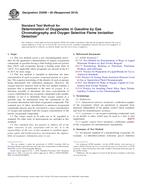We need your consent to use the individual data so that you can see information about your interests, among other things. Click "OK" to give your consent.
ASTM D5599-00(2010)
Standard Test Method for Determination of Oxygenates in Gasoline by Gas Chromatography and Oxygen Selective Flame Ionization Detection
STANDARD published on 1.10.2010
The information about the standard:
Designation standards: ASTM D5599-00(2010)
Note: WITHDRAWN
Publication date standards: 1.10.2010
SKU: NS-31821
The number of pages: 8
Approximate weight : 24 g (0.05 lbs)
Country: American technical standard
Category: Technical standards ASTM
Annotation of standard text ASTM D5599-00(2010) :
Keywords:
alcohols, DIPE (Di-iso-propylether), ETBE (ethyl tert-butylether), ethanol, gas chromatography, gasoline, methanol, MTBE (methyl tert-butylether), oxygenates, oxygen-selective detection, TAME (tert-amylmethylether), Alcohol, Automotive engine fuels/oils, DIPE (diisopropylether), ETBE (ethyl tert-butyl ether), Ethanol, Gas chromatography (GC)--petroleum products, Methanol (methyl alcohol), MTBE (methyl tert-butylether), Organic oxygenated compounds, Oxygenated aromatics
Additional information
| Significance and Use | ||||||||||||
|
In gasoline blending, the determination of organic oxygenated compounds is important. Alcohols, ethers, and other oxygenates are added to gasoline to increase the octane number and to reduce tailpipe emissions of carbon monoxide. They must be added in the proper concentration and ratios to meet regulatory limitations and to avoid phase separation and problems with engine performance or efficiency. This test method provides sufficient oxygen-to-hydro-carbon selectivity and sensitivity to allow determination of oxygenates in gasoline samples without interference from the bulk hydrocarbon matrix. |
||||||||||||
| 1. Scope | ||||||||||||
|
1.1 This test method covers a gas chromatographic procedure for the quantitative determination of organic oxygenated compounds in gasoline having a final boiling point not greater than 220°C and oxygenates having a boiling point limit of 130°C. It is applicable when oxygenates are present in the 0.1 to 20 % by mass range. 1.2 This test method is intended to determine the mass concentration of each oxygenate compound present in a gasoline. This requires knowledge of the identity of each oxygenate being determined (for calibration purposes). However, the oxygen-selective detector used in this test method exhibits a response that is proportional to the mass of oxygen. It is, therefore, possible to determine the mass concentration of oxygen contributed by any oxygenate compound in the sample, whether or not it is identified. Total oxygen content in a gasoline may be determined from the summation of the accurately determined individual oxygenated compounds. The summed area of other, uncalibrated or unknown oxygenated compounds present, may be converted to a mass concentration of oxygen and summed with the oxygen concentration of the known oxygenated compounds. 1.3 The values stated in SI units are to be regarded as standard. No other units of measurement are included in this standard. 1.4 This standard does not purport to address all of the safety concerns, if any, associated with its use. It is the responsibility of the user of this standard to establish appropriate safety and health practices and determine the applicability of regulatory limitations prior to use. |
||||||||||||
| 2. Referenced Documents | ||||||||||||
|
We recommend:
Updating of laws
Do you want to be sure about the validity of used regulations?
We offer you a solution so that you could use valid and updated legislative regulations.
Would you like to get more information? Look at this page.




 Cookies
Cookies
